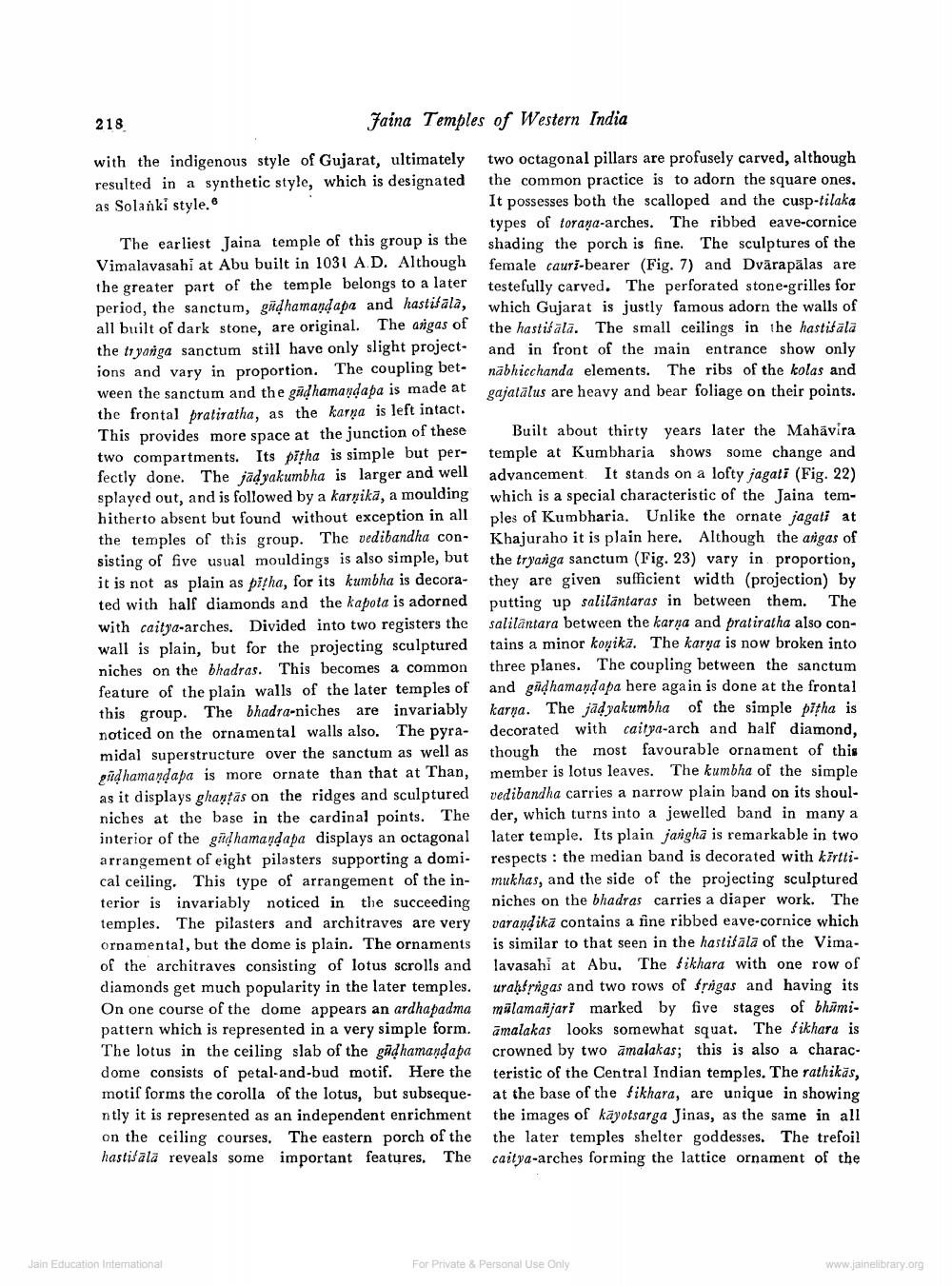________________
218
Faina Temples of Western India
with the indigenous style of Gujarat, ultimately two octagonal pillars are profusely carved, although resulted in a synthetic style, which is designated the common practice is to adorn the square ones, as Solanki style.
It possesses both the scalloped and the cusp-lilaka
types of torana-arches. The ribbed eave-cornice The earliest Taina temple of this group is the shading the porch is fine. The sculptures of the Vimalayasabi at Abu built in 1031 AD. Although female cauri-bearer (Fig. 7) and Dvärapalas are the greater part of the temple belongs to a later testefully carved. The perforated stone-grilles for period, the sanctum, güdhamand apz and hastatala, which Gujarat is justly famous adorn the walls of all built of dark stone, are original. The angas of the hastišala. The small ceilings in the hastifāla the ti yanga sanctum still have only slight project and in front of the main entrance show only ions and vary in proportion. The coupling bet nābhicchanda elements. The ribs of the kolas and ween the sanctum and the gūdhamandaba is made at gajatālus are heavy and bear foliage on their points. the frontal pratiratha, as the karna is left intact. This provides more space at the junction of these Built about thirty years later the Mahavira two compartments. Its pitha is simple but per- temple at Kumbharia shows some change and fectly done. The jad yakumbha is larger and well advancement. It stands on a lofty jagati (Fig. 22) splayed out, and is followed by a karņikā, a moulding which is a special characteristic of the Jaina temhitherto absent but found without exception in all ples of Kumbharia. Unlike the ornate jagati at the temples of this group. The vedibandha con- Khajuraho it is plain here. Although the angas of sisting of five usual mouldings is also simple, but the tryanga sanctum (Fig. 23) vary in proportion, it is not as plain as pisha, for its kumbha is decora- they are given sufficient width (projection) by ted with half diamonds and the kapota is adorned putting up saliläntaras in between them. The with caitya-arches. Divided into two registers the salilantara between the karņa and pratiratha also conwall is plain, but for the projecting sculptured tains a minor kopika. The karya is now broken into niches on the bhadras. This becomes a common three planes. The coupling between the sanctum feature of the plain walls of the later temples of and gadhamandapa here again is done at the frontal this group. The bhadra-niches are invariably karya. The jādyakumbha of the simple pitha is noticed on the ornamental walls also. The pyra- decorated with caitya-arch and half diamond, midal superstructure over the sanctum as well as though the most favourable ornament of this gūdhamaydapa is more ornate than that at Than, member is lotus leaves. The kumbha of the simple as it displays ghantäs on the ridges and sculptured vedibandha carries a narrow plain band on its shoulniches at the base in the cardinal points. The der, which turns into a jewelled band in many a interior of the grdhamaydapa displays an octagonal later temple. Its plain jangha is remarkable in two arrangement of eight pilasters supporting a domi- respects: the median band is decorated with kirttical ceiling. This type of arrangement of the in- mukhas, and the side of the projecting sculptured terior is invariably noticed in the succeeding niches on the bhadras carries a diaper work. The temples. The pilasters and architraves are very varandikā contains a fine ribbed eave-cornice which ornamental, but the dome is plain. The ornaments is similar to that seen in the hastiśālā of the Vimaof the architraves consisting of lotus scrolls and lavasahi at Abu. The Sikhara with one row of diamonds get much popularity in the later temples. urahtrigas and two rows of frigas and having its On one course of the dome appears an ardhapadma mülamasljari marked by five stages of bhimipattern which is represented in a very simple form. amalakas looks somewhat squat. The Sikhara is The lotus in the ceiling slab of the gūdhamandapa crowned by two amalakas; this is also a characdome consists of petal-and-bud motif. Here the teristic of the Central Indian temples. The rathikäs, motif forms the corolla of the lotus, but subseque. at the base of the Sikhara, are unique in showing ntly it is represented as an independent enrichment the images of kayotsarga Jinas, as the same in all on the ceiling courses. The eastern porch of the the later temples shelter goddesses. The trefoil hastišala reveals some important features. The caitya-arches forming the lattice ornament of the
Jain Education Intemational
For Private & Personal Use Only
www.jainelibrary.org




